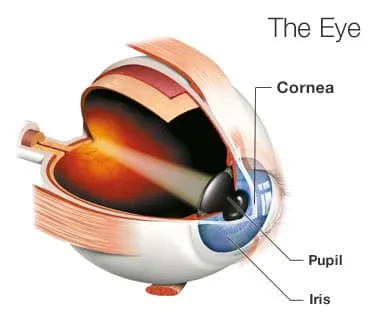Scratched Cornea
A corneal abrasion is a scratch on your eye. It can happen in an instant. You poke your eye, or something gets trapped under your eyelid, like dirt or sand. Your eye hurts, and it doesn’t get better when you close it – if you can keep it shut. Light makes it sting and burn.
It’s actually on your cornea. That’s the clear layer that covers the iris, the colored part of your eye. It also shields the pupil – the black circle in the middle of your eye.

Scratched Cornea Causes
You might get a scratch if you:
- Poke your eye with a fingernail, pen, or makeup brush
- Get dirt, sand, sawdust, ash, or some other foreign matter in your eye
- Get chemicals in your eye
- Rub it too hard
- Wear poor-fitting or dirty contact lenses
- Get a certain type of eye infection
- Have surgery without proper eye protection
- Play sports or engage in high-risk physical activity without safety eyewear
- Overwear your contact lenses
You may not feel symptoms right away. As a result, you may not be able to figure out what caused it.
Can It Be Prevented?
Yes. If you feel like there’s something in your eye, you’re going to want to rub it. Don't – that’s how you get a scratch. Do this instead:
- Blink your eye several times.
- Pull your upper eyelid over the lower eyelid.
- Gently rinse your eye out with clean water or a sterile saline solution.
Don’t try to remove anything that’s stuck onto your cornea. Only a doctor should do that.
If you still feel like something’s in your eye, see an eye doctor as soon as you can or go to the emergency room. The doctor will look at your eye and use a product called eye stain that lets them see the surface of your cornea. If something is on it or in it, they can safely remove it.
Scratched Cornea Symptoms
If you've scratched your eye before, you’ll probably remember how it feels. If not, you might:
- Feel like you have sand or grit in your eye
- Have pain, especially when you open or close your eye
- Notice tearing and redness
- Become sensitive to light
- Have blurred vision
Scratched Cornea Treatment
- Inspect the eye for small particles that may be stuck under the eyelid and causing symptoms.
- Flush the eye with clean water or saline solution once or twice to remove any particles or to soothe the eye surface. Do not rinse the eye more than a few times. Doing so can make the situation worse.
- Avoid rubbing or pressing on the eye.
Your doctor may prescribe antibiotic eyedrops or ointment to keep your eye from getting infected. They might also give you medicated eyedrops to ease pain and redness, along with pain medicine. They might tape your eye shut and have you wear a patch over your eye to keep light from bothering it.
A minor scratch should heal on its own in 1 to 3 days. More severe abrasions may take longer.
While your eye heals:
- Don’t rub your eye.
- Don’t wear contacts until your eye doctor says it’s safe to do so.
- Wear sunglasses to ease discomfort caused by sunlight.
You should fully recover from a minor scratch without permanent eye damage. But deep scratches can cause infections, scars, and other problems. If you don’t take care of them, they can lead to long-term vision problems. Report any unusual symptoms, including a return of pain after treatment, to your eye doctor.
When to Go to the Doctor
Seek emergency care if:
- There is pain, a change in vision, or your eye is more sensitive to light after a scratch or trauma to the eyeball.
- There is a foreign object lodged in the eye or eyelid or under the eyelid.
- There is loss of vision.
- Something hit the eye at high speed or with high force.
When to See a Health Care Provider
Get medical help if:
You have blurred vision or eye pain, tearing, redness, light sensitivity, irritation, or a hard time opening the eye, even if there does not appear to be something in the eye. There may be a scratch on the surface of the eye called a corneal abrasion.
Follow Up
If you see a health care provider:
- The health care provider will examine the eye for damage, remove any particles, and check the vision.
- Antibiotic ointment or pain relievers may be prescribed.
- Small surface corneal abrasions heal in a couple of days. Pain medications such as acetaminophen or ibuprofen can be taken for pain. Avoid ibuprofen and other NSAIDs if the person has heart failure or kidney failure.
For larger abrasions, a bandage contact lens may be placed to aid with comfort and healing. For severe or non-healing abrasions, care from an ophthalmologist (eye surgeon) may be needed.
